Bandelier
The following morning, the Professor lights the already-built fire (LUXURY), and we listen to New Age Native American flute music, which is sort of unlike us, but perfect in this context. He reads the local paper – the Santa Fe New Mexican – and I read a fascinating article in Harper’s all about the Buffalo Commons. We have decided to re-try taking on Bandelier on this day, but still linger over our coffee. Ahh, these peaceful, slow morning starts – what bliss!
Mid-morning, we climb into the car and head off to Bandelier – by way of a Sunglasses Hut (where the Professor procures a pair of Prada sunnies after misplacing his old ones). Bandelier National Monument is the old site of a Pueblo settlement, occupied from 1150-1550 before drought and heat chased the inhabitants away. While there, the natives chopped bricks out of the surrounding volcanic rock and used them to build multi-story homes – many butting up against the sheer rock wall of the valley cliffsides, using its bulk for lateral support. They also carved caves out of the cliffsides, smoking the ceilings to keep the soft rock from crumbling into their soup. It is gorgeous, and it was also blazingly bright and hot on the day we went. Many of my photos have a ghostly glare, and I think it comes from the punishing direct sunlight.
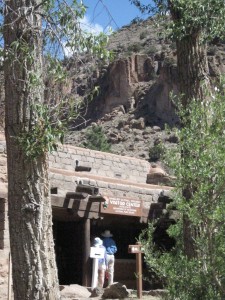
To get down to Bandelier, we have to park in a Park and Ride lot near Los Alamos, then ride in a shuttle to the valley floor. Our shuttle driver has the emblem from the New Mexico flag tattooed on his forearm, but there is no mistaking that he is from Pittsburgh. That accent (still lingering in my parents’ speech) is undeniable.
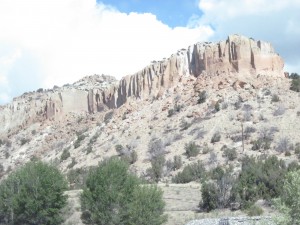
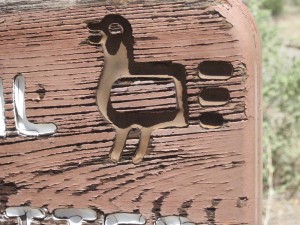
There was recently a fire in Bandelier, which led to an increased risk of flash flooding (for some reason – I suppose because of erosion?) This is why we had to take a shuttle to the valley floor – because the visitor’s center and parking lots frequently flood, putting cars (not to mention lives) at risk. Before we depart on our circuit hike, the rangers show us a video of the visitor’s center and valley floor under rushing, flash flood waters, and then calmly tell us that if a flash flood occurs while we are hiking, we are to scramble to as high an elevation as we can safely attain and then hang out and wait til someone comes to get us. I am simultaneously alarmed, and also pleased that they still let people out there, that they trust us as adults to be able to suss out flash flood danger and get ourselves to safety.
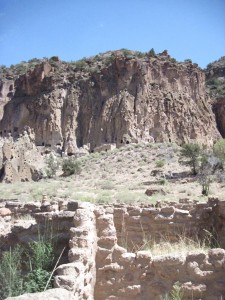
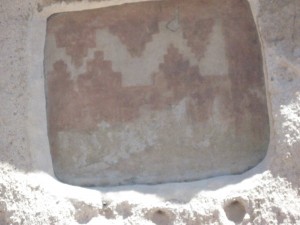
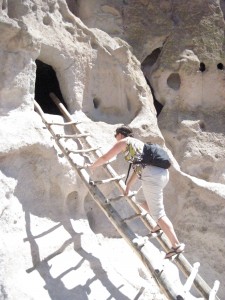
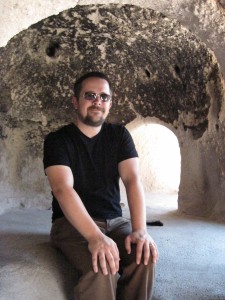
Inside the little caves it is very cool, sandy. The rock crumbles into fine sand every time you touch it. I can’t believe these things still exist, that they haven’t been eroded into a pile of dirt by now. It would have driven me crazy to live in such dust all the time, but I suppose they laid straw or something to mitigate the dust. Most of the caves are low-ceilinged – but there is one large one in which I (5’6″) could stand.
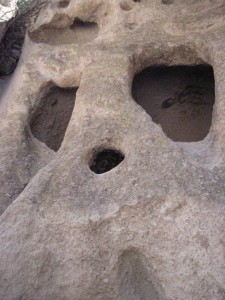
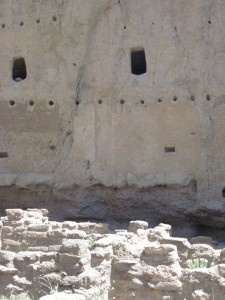
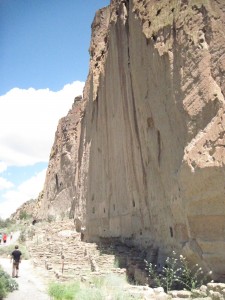
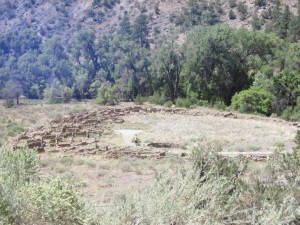
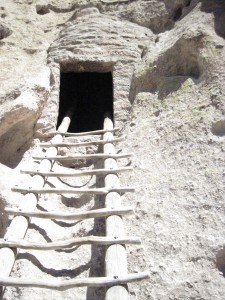
We wander along the loop path, cross a low river, and stroll through a lovely and cool pine forest on the other side. We step over a large scat in the middle of the path – we later discover it was left by a bear. A rancher and his wife, the Freys, formerly ran the Ranch of the 10 Elders on the bank of this river. It was a retreat destination in the first half of the twentieth century, and even though eventually it had to cease operations after the rancher passed away, the Park Service permitted Mrs. Frey to live there until she died. She led tours and nature walks, as knowledgeable and enthusiastic as any forest service ranger.
After taking the return shuttle, we collect our rented car and drive to Los Alamos for a forgettable lunch, and then go on to a nearby outlook, recommended by the shuttle driver. We follow battered old white Ford F150 down a winding road through desert sand and scrubby little trees, and park behind the truck in the shade of a juniper. An older guy in a fisherman’s hat steps out of the truck and greets us, and we walk together to the outlook. We are greeted by a stunning vista: the stream-like Rio Grande, mountain tops, dormant volcanoes, and even bits of distant Colorado.
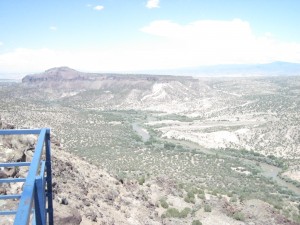
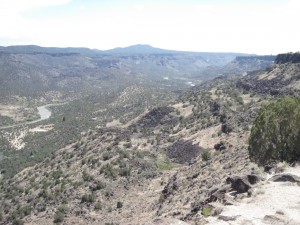
After a minute or so of battling to keep his hat on his head in the heavy winds, the older man casually starts a conversation with us that ends up lasting over half an hour. It turns out he is a native to the area – he grew up clambering in and out of the amazing canyons that open up below us – and he often comes up to the overlook to volunteer his services as a guide/ranger/storyteller. He tells us how the rent in the ground that is filled by the Rio Grande is the site of a continental rift, a dramatic collision of the Earth’s plates over a million years ago. He tells a story about a woman ranger who was patrolling nearby at one point. She encountered a mountain lion, walking toward her on the path. She and the lion both elected to ignore one another, and they casually strolled past each other on the path. I could practically see the big cat shoving his hands in his pockets and whistling – “Nothing to see here!” He talks about how big old rattlers would sleep on the banks of the river below, and how he and his buddies would shoot them in the head with a .22. He describes the volcanoes – he knows the last time each of them erupted. He gives the Professor the names of each of the nearby peaks, and their elevation. I thoroughly enjoy the lesson – though I think the man enjoys it more – sharing his library of knowledge.
Eventually the wind and sun chase us back into our car. We bid our new friend a fond farewell, and then head home, where an afternoon of massages at the spa awaits. Nice life, huh? I sip lemon water, go from hot tub to steam room to cold shower and back again, and eventually am led to a quiet room where a kind woman named Sue beats my shoulders into submission. She says I have swimmer’s shoulders, which makes me think I should abandon running and take up swimming instead. The Professor’s masseuse knew his family very well, and they giddily talk about the old days, asking after second cousins and spouses and kids. We try our best to account for everyone, though it is the Professor’s grandfather who keeps the best track of the family branches.
After massages, we dress and head to the resort’s swanky bar. We have a Stella and watch the sunset, sitting at a fire circle outside on the porch. I see Venus, a bright pinpoint of light. (It must be Venus, it can’t be a star.) We order bar food – burgers, fish tacos – and then head home to find another split of champagne and chocolate-covered strawberries, a kind note from our massage therapists who enjoyed a connection to their happy past. We light an evening fire, and enjoy another quiet evening together. Only a couple of days left.